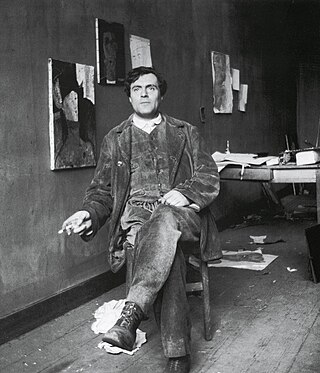
Amedeo Clemente Modigliani was an Italian painter and sculptor of the École de Paris who worked mainly in France. He is known for portraits and nudes in a modern style characterized by a surreal elongation of faces, necks, and figures — works that were not received well during his lifetime, but later became much sought-after. Modigliani spent his youth in Italy, where he studied the art of antiquity and the Renaissance. In 1906, he moved to Paris, where he came into contact with such artists as Pablo Picasso and Constantin Brâncuși. By 1912, Modigliani was exhibiting highly stylized sculptures with Cubists of the Section d'Or group at the Salon d'Automne.

Chaïm Soutine was a French painter of Belarusian-Jewish origin of the School of Paris, who made a major contribution to the expressionist movement while living and working in Paris.

Moïse Kisling was a Polish-born French painter. Born in Kraków, then part of Austria-Hungary, to Jewish parents, Kisling studied at the Academy of Fine Arts. He left for Paris in 1910 at the age of 19. After moving to Montmartre, Kisling became a member of the Parisian avant-garde known also as the School of Paris, and developed close professional relationships with painters Amedeo Modigliani and Jules Pascin, among others. Kisling gained recognition for portraying the female form and completed numerous nudes and portraits during his career.

Jim Dine is an American artist. Dine's work includes painting, drawing, printmaking, sculpture and photography; his early works encompassed assemblage and happenings, while in recent years his poetry output, both in publications and readings, has increased.

Les Demoiselles d'Avignon is a large oil painting created in 1907 by the Spanish artist Pablo Picasso. Part of the permanent collection of the Museum of Modern Art in New York, it portrays five nude female prostitutes in a brothel on Carrer d'Avinyó, a street in Barcelona, Spain. The figures are confrontational and not conventionally feminine, being rendered with angular and disjointed body shapes, some to a menacing degree. The far left figure exhibits facial features and dress of Egyptian or southern Asian style. The two adjacent figures are in an Iberian style of Picasso's Spain, while the two on the right have African mask-like features. Picasso said the ethnic primitivism evoked in these masks moved him to "liberate an utterly original artistic style of compelling, even savage force” leading him to add a shamanistic aspect to his project.

Alfred Henry Maurer was an American modernist painter. He exhibited his work in avant-garde circles internationally and in New York City during the early twentieth century. Highly respected today, his work met with little critical or commercial success in his lifetime, and he died, a suicide, at the age of sixty-four.

Eugeniusz Zak, also known as Eugène Zak and Eugene Zak, was a Polish artist.
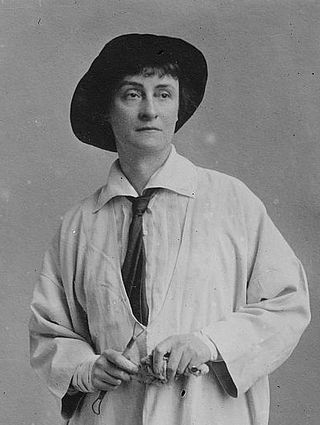
Janet Scudder, born Netta Deweze Frazee Scudder, was an American sculptor and painter from Terre Haute, Indiana, who is best known for her memorial sculptures, bas-relief portraiture, and portrait medallions, as well as her garden sculptures and fountains. Her first major commission was the design for the seal of the New York Bar Association around 1896. Scudder's Frog Fountain (1901) led to the series of sculptures and fountains for which she is best known. Later commissions included a Congressional Gold Medal honoring Domício da Gama and a commemorative medal for Indiana's centennial in 1916. Scudder also displayed her work at numerous national and international exhibitions in the United States and in Europe from the late 1890s to the late 1930s. Scudder's autobiography, Modeling My Life, was published in 1925.

Félix Édouard Vallotton was a Swiss and French painter and printmaker associated with the group of artists known as Les Nabis. He was an important figure in the development of the modern woodcut. He painted portraits, landscapes, nudes, still lifes, and other subjects in an unemotional, realistic style.

Cubist sculpture developed in parallel with Cubist painting, beginning in Paris around 1909 with its proto-Cubist phase, and evolving through the early 1920s. Just as Cubist painting, Cubist sculpture is rooted in Paul Cézanne's reduction of painted objects into component planes and geometric solids; cubes, spheres, cylinders, and cones. Presenting fragments and facets of objects that could be visually interpreted in different ways had the effect of 'revealing the structure' of the object. Cubist sculpture essentially is the dynamic rendering of three-dimensional objects in the language of non-Euclidean geometry by shifting viewpoints of volume or mass in terms of spherical, flat and hyperbolic surfaces.

Lizzie Plummer Bliss, known as Lillie P. Bliss, was an American art collector and patron. At the beginning of the 20th century, she was one of the leading collectors of modern art in New York. One of the lenders to the landmark Armory Show in 1913, she also contributed to other exhibitions concerned with raising public awareness of modern art. In 1929, she played an essential role in the founding of the Museum of Modern Art. After her death, 150 works of art from her collection served as a foundation to the museum and formed the basis of the in-house collection. These included works by artists such as Paul Cézanne, Georges Seurat, Paul Gauguin, Henri Matisse, Pablo Picasso and Amedeo Modigliani.

Jacques and Berthe Lipchitz is a 1916 oil on canvas painting by Amedeo Modigliani. It depicts Modigliani's friend, the sculptor Jacques Lipchitz, standing alongside his seated wife Berthe.
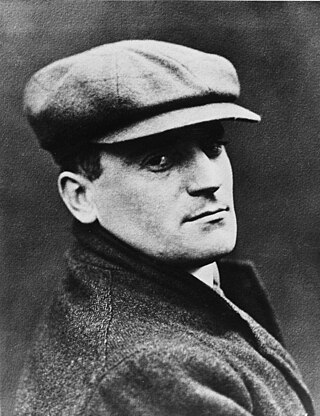
Hugh Blaker (1873–1936) was an English artist, collector, connoisseur, dealer in Old Masters, museum curator, writer on art, and a supporter and promoter of modern British and French painters.
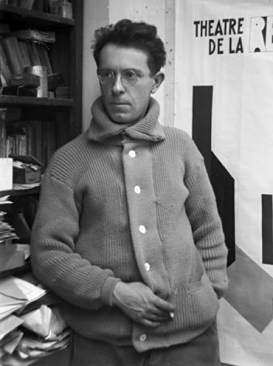
Joseph Csaky was a Hungarian avant-garde artist, sculptor, and graphic artist, best known for his early participation in the Cubist movement as a sculptor. Csaky was one of the first sculptors in Paris to apply the principles of pictorial Cubism to his art. A pioneer of modern sculpture, Csaky is among the most important sculptors of the early 20th century. He was an active member of the Section d'Or group between 1911 and 1914, and closely associated with Crystal Cubism, Purism, De Stijl, Abstract art, and Art Deco throughout the 1920s and 1930s.

Modern sculpture is generally considered to have begun with the work of Auguste Rodin, who is seen as the progenitor of modern sculpture. While Rodin did not set out to rebel against the past, he created a new way of building his works. He "dissolved the hard outline of contemporary Neo-Greek academicism, and thereby created a vital synthesis of opacity and transparency, volume and void". Along with a few other artists in the late 19th century who experimented with new artistic visions in sculpture like Edgar Degas and Paul Gauguin, Rodin invented a radical new approach in the creation of sculpture. Modern sculpture, along with all modern art, "arose as part of Western society's attempt to come to terms with the urban, industrial and secular society that emerged during the nineteenth century".
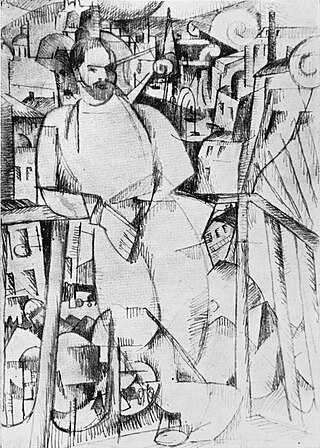
Man on a Balcony, is a large oil painting created in 1912 by the French artist, theorist and writer Albert Gleizes (1881–1953). The painting was exhibited in Paris at the Salon d'Automne of 1912. The Cubist contribution to the salon created a controversy in the French Parliament about the use of public funds to provide the venue for such 'barbaric art'. Gleizes was a founder of Cubism, and demonstrates the principles of the movement in this monumental painting with its projecting planes and fragmented lines. The large size of the painting reflects Gleizes's ambition to show it in the large annual salon exhibitions in Paris, where he was able with others of his entourage to bring Cubism to wider audiences.

Groupe de femmes, also called Groupe de trois femmes, or Groupe de trois personnages, is an early Cubist sculpture created circa 1911 by the Hungarian avant-garde, sculptor, and graphic artist Joseph Csaky (1888–1971). This sculpture formerly known from a black and white photograph had been erroneously entitled Deux Femmes , as the image captured on an angle showed only two figures. An additional photograph found in the Csaky family archives shows a frontal view of the work, revealing three figures rather than two. Csaky's sculpture was exhibited at the 1912 Salon d'Automne, and the 1913 Salon des Indépendants, Paris. A photograph taken of Salle XI in sitiu at the 1912 Salon d'Automne and published in L'Illustration, 12 October 1912, p. 47, shows Groupe de femmes exhibited alongside the works of Jean Metzinger, František Kupka, Francis Picabia, Amedeo Modigliani and Henri Le Fauconnier.
Woman Ironing is a 1904 oil painting by Pablo Picasso that was completed during the artist's Blue Period (1901—1904). This evocative image, painted in neutral tones of blue and gray, depicts an emaciated woman with hollowed eyes, sunken cheeks, and bent form, as she presses down on an iron with all her will. A recurrent subject matter for Picasso during this time is the desolation of social outsiders. This painting, as the rest of his works of the Blue Period, is inspired by his life in Spain but was painted in Paris.
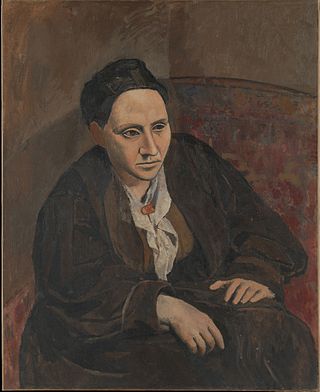
Portrait of Gertrude Stein is an oil-on-canvas painting of the American writer and art collector Gertrude Stein by Pablo Picasso, which was begun in 1905 and finished the following year. The painting is housed in the Metropolitan Museum of Art in New York. It is considered one of the important works of Picasso's Rose Period. The portrait has historical significance, due to the subject's role in Picasso's early life as a struggling artist and eventual commercial success. It also represents a significant transitional step in the artist's move towards Cubism.

Alice is a c.1918 oil on canvas painting by Amedeo Modigliani. It now hangs in the Danish National Gallery, to which it was donated in 1928.



















